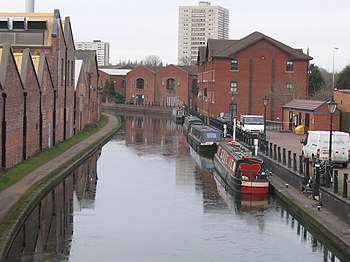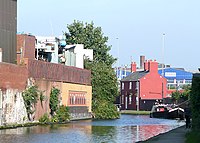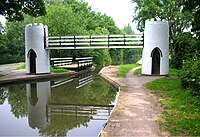Birmingham and Fazeley Canal

The Birmingham and Fazeley Canal is a canal of the Birmingham Canal Navigations in Warwickshire and Staffordshire. Its purpose was to provide a link between the Coventry Canal and Birmingham and thereby connect Birmingham to London by way of the Oxford Canal.[1]
History
The story of the Birmingham and Fazeley begins in 1770, when the Birmingham Canal Company was seen as having a monopoly. At the time, the coalfields at Walsall did not have canal access, and a public meeting was held at Lichfield on 18 August, to discuss an independent link from Walsall to Fradley Junction on the Trent and Mersey Canal, passing through Lichfield. Opposition from local landowners resulted in the plan being shelved, but a further plan was proposed at a meeting held in Warwick in August 1781, for a canal to run from Wednesbury through Fazeley to Atherstone, which was the end of the Coventry Canal at the time. The plans were changed somewhat in October, but shareholders in the Birmingham Canal saw it as a serious threat.[2]
Two bills were put before Parliament in 1782, one for the Birmingham and Fazeley, and a rival one from the Birmingham Canal for a branch from Wednesbury to Walsall. Both sides opposed the other's proposal, and both bills were defeated.[2] The promoters then opened negotiations with other canal companies, to ensure that when the canal was built, it would be part of a larger network. In 1782, they obtained an agreement from the Oxford Canal Company that they would complete the route to the River Thames at Oxford, one from the Coventry Canal that they would extend their canal from Atherstone to Fazeley, and agreed that they would complete the Coventry Canal's route from Fazeley as far as Whittington, as the Coventry Canal company could not finance the whole route. The Trent and Mersey would finish that link by building the remainder of the route to Fradley Junction.[3] A second bill was put before Parliament, and at the same time, the Birmingham Canal presented a scheme for a canal from Riders Green to Broadwaters, near Walsall, with eight branches, and a second canal from Newhall to Fazeley. The Birmingham and Fazeley was authorised by an Act of Parliament obtained in 1784. The new company and the Birmingham Canal merged soon afterwards, becoming the awkwardly named Birmingham & Birmingham & Fazeley Canal Company.[2]
John Smeaton was the engineer employed by the Birmingham and Fazeley, but work did not start immediately, as he was also responsible for the Riders Green to Broadwaters line, which was completed first.[2] The project did not go smoothly, as there were disputes between James Bough, the superintendent of the canal company, and Pinkertons, who were the civil engineering contractors employed to carry out the work. The issue concerned the cement that the Pinkertons were using.[4] Work on the Fazeley line began in April 1786,[2] with Bough still acting as superintenent, and the Pinkertons responsible for the construction of the section between Minworth and Fazeley. In late 1786, George Pinkerton found out that the levels, which had been surveyed by Bough, were wrong. Samuel Bull, the engineer for the canal company, investigated and reported that Pinkerton was right. The Pinkertons started to work on the project from January 1787, even though the contracts were not signed until May. Bough made a series of allegations that Pinkertons' workmanship and the materials used were of poor quality.[4]
The company stopped paying Pinkerton in late 1788, as the costs were exceeding the original estimates, and the contract was taken away from them in February 1789. There was then a financial dispute over money which had been paid to Pinkerton as "extras", but which the company then claimed were overpayments. Some £2,750 was at issue, and the case rumbled on for a decade, until a court case in 1801 gave him only £436 of the claim. Unhappy with the outcome, Pinkerton justified his position, but his remarks about John Houghton, the Company Clerk, were deemed to be libellous, for which he was fined and spent some time in prison.[4]
The canal was completed in August 1789.[2] The benefits of the co-operation with the other canal companies were that when all the links were completed in 1790, it immediately generated a great deal of freight traffic. This created problems, as the flights of locks at Aston and Farmer's Bridge became congested, and this became worse when the Warwick Canal built a junction onto the Digbeth Branch. The problem was not solved until 1844, when the Birmingham and Warwick Junction Canal to the south east and the Tame Valley Canal to the north west were opened.[3] The name of the Birmingham & Birmingham & Fazeley Canal Company was changed to Birmingham Canal Navigations in 1794.[2]
Route
The canal is now regarded as running from the BCN Main Line at Old Turn Junction (near the National Indoor Arena), Birmingham to the Coventry Canal at Fazeley Junction, just outside Tamworth. The length of this stretch is 15 miles, and it includes 38 locks.[3] From Old Turn Junction, 13 locks drop the level of the canal by 81 feet, after which there is a short flat stretch from St Chads Cathedral to Aston Junction. There is a one-mile branch called the Digbeth Branch Canal which runs from the junction to Typhoo Basin and contains 6 locks. A short cut runs from near the end of the branch to the Grand Union Canal at Bordesley Junction.[5]
Below the junction there are another 11 locks, which form the Aston flight. Holborn Hill bridge carries the railway to Aston station over the canal, just before the bottom lock of the flight is reached. At Salford Junction, the Tame Valley Canal runs to the north west, and the Grand Union Canal runs southwards, while the Fazeley heads eastwards. Two more locks continue the descent at Minworth, and the character of the surroundings changes from an urban and industrial landscape to open countryside. There is a short 57-yard tunnel at Curdworth, after which fields and flooded gravel pits line the canal. At Drayton Bassett, an eccentric footbridge with Gothic-style towers crosses the canal, close to Drayton Manor Theme Park, after which Fazeley is reached, where the canal joins the Coventry Canal.[6]
The 5½ mile stretch which extends northwards beyond Fazeley Junction to Whittington, near Lichfield, was built by the Birmingham and Fazeley Canal Company, although it was built on the route authorised by the Coventry Canal's Act of Parliament. This section is now regarded as being part of the Coventry Canal.[7]
Historically the canal started at Farmer's Bridge Top Lock (the real Farmer's Bridge Junction), where it met the already existing Birmingham Canal Newhall Branch. That branch has now been built over, with only Cambrian Wharf surviving.
The Birmingham and Fazeley Canal forms part of the Warwickshire ring.
Features


At Common lock 10, on the lower lock tail, an inscription can be found in the stonework. It reads: "Pax Missa Per Orbem, Pax Quaeritur Bello", which translates as "Peace Is Sent Throughout The World, Peace Is Sought Through War". The inscription comes from two coins, the first part from the Queen Ann Farthing, and the second part from the Cromwell Broad.[8]
- Old Turn Junction: 52°28’45"N, 1°54’50"W; SP058868 (BCN Main Line)
- Stour Valley railway tunnel: 52°28’46"N, 1°54’50"W; SP058868 (Birmingham, Wolverhampton and Stour Valley Railway runs beneath canal)
- Farmer's Bridge Junction (original): 52°28’50"N, 1°54’45"W; SP059870 (Junction with former Birmingham Canal Newhall Branch)
- Cambrian Wharf basin: 52°28’50"N, 1°54’42"W; SP059870
- Newhall Branch (closed): 52°28’51"N, 1°54’40"W; SP060870
- Farmer's Bridge top lock 1: 52°28’51"N, 1°54’43"W; SP059870
- Farmer's Bridge lock 2: 52°28’52"N, 1°54’40"W;
- Farmer's Bridge lock 3: 52°28’53"N, 1°54’36"W;
- Farmer's Bridge lock 4: 52°28’53"N, 1°54’33"W;
- Farmer's Bridge lock 5: 52°28’55"N, 1°54’30"W;
- Farmer's Bridge lock 6: 52°28’56"N, 1°54’27"W;
- Farmer's Bridge lock 7: 52°28’57"N, 1°54’25"W;
- Whitmore Arm junction: 52°28’58"N, 1°54’24"W; (dry)
- Farmer's Bridge lock 8: 52°28’58"N, 1°54’23"W;
- Farmer's Bridge lock 9: 52°28’60"N, 1°54’21"W; (Directly under Newhall Street)
- Farmer's Bridge lock 10: 52°29’1"N, 1°54’18"W; (Directly under Brindley House)
- British Telecom Tower: 52°29’1"N, 1°54’15"W;
- Farmer's Bridge lock 11: 52°29’3"N, 1°54’15"W;
- Farmer's Bridge lock 12: 52°29’6"N, 1°54’10"W;
- Birmingham Snow Hill station bridge: 52°29’7"N, 1°54’8"W;
- Farmer's Bridge bottom lock 13: 52°29’9"N, 1°54’4"W; SP067875
- A38 road: 52°29’25"N, 1°53’22"W; SP075880
- Aston Junction: 52°29’25"N, 1°53’19"W; SP075880 (Digbeth Branch Canal)
- Aston top lock 14: 52°29’25"N, 1°53’18"W; SP075881
- Aston lock 15: 52°29’27"N, 1°53’14"W;
- Aston lock 16: 52°29’29"N, 1°53’12"W;
- Aston lock 17: 52°29’30"N, 1°53’9"W;
- Aston lock 18: 52°29’33"N, 1°53’7"W;
- Aston lock 19: 52°29’34"N, 1°53’5"W;
- Aston lock 20: 52°29’38"N, 1°52’60"W;
- Aston lock 21: 52°29’41"N, 1°52’57"W;
- Aston lock 22: 52°29’55"N, 1°52’39"W;
- Aston lock 23: 52°30’2"N, 1°52’24"W;
- Aston bottom lock 24: 52°30’13"N, 1°52’16"W; SP087895 (Cross-City Line)
- Salford Junction: 52°30’31"N, 1°51’33"W; SP095901 (Tame Valley Canal, Grand Union Canal)
- Factory over canal: 52°30’30"N, 1°50’42"W; SP105900 (150 yards under factory buildings, open on one side)
- Erdington Hall Bridge: 52°30’29"N, 1°50’36"W; SP106900 (Original site of bridge)
- Minworth top lock: 52°31’21"N, 1°47’45"W; SP138916
- Minworth middle lock: 52°31’31"N, 1°47’25"W; SP142919
- Minworth bottom lock: 52°31’44"N, 1°46’39"W; SP150923
- Curdworth Tunnel: 52°32’11"N, 1°44’20"W; SP177932
- M6 Toll motorway bridge: 52°32’28"N, 1°43’47"W; SP183937
- Curdworth top lock 1: 52°32’29"N, 1°43’44"W; SP183937
- Curdworth lock 2: 52°32’44"N, 1°43’18"W; SP190942
- Curdworth lock 3: 52°32’47"N, 1°43’14"W; SP190943
- Curdworth lock 4: 52°32’50"N, 1°43’11"W; SP191944
- Curdworth lock 5: 52°32’54"N, 1°43’8"W; SP192945
- Curdworth lock 6: 52°33’1"N, 1°43’3"W; SP197947
- Curdworth lock 7: 52°33’16"N, 1°42’50"W; SP195952
- Curdworth lock 8: 52°33’37"N, 1°42’36"W; SP198959
- Curdworth lock 9: 52°33’45"N, 1°42’33"W; SP198961
- Common Lock 10: 52°34’4"N, 1°42’23"W; SP200967
- Kigsbury swivel bridge: 52°34’23"N, 1°42’13"W; SP200973
- Curdworth bottom lock 11: 52°34’24"N, 1°42’13"W; SP202973
- Aqueduct: 52°35’12"N, 1°42’18"W; SP199988 (Near Middleton Hall)
- Drayton swivel and ornamental bridges: 52°36’17"N, 1°42’23"W; SK198008
- Fazeley Mill Marina: 52°36’36"N, 1°42’12"W; SK200014
- Watling Street: 52°36’54"N, 1°42’4"W; SK202020
- Fazeley Junction: 52°36’55"N, 1°42’4"W; SK202020 (Coventry Canal (to Coventry). Continues as de facto B&F to Whittington)
- Whittington Brook: 52°40’21"N, 1°45’20"W; SK165083 (Coventry Canal (detached part) to Huddlesford Junction)
Gallery
-
Part of the Farmer's Bridge flight looking towards the BT tower
-
Underneath Brindley House, part of the BT Tower complex
-
Farmer's Bridge Lock 9 and extended pound, running through two arches of the Newhall Street bridge in central Birmingham. There is a lock gate on either side of the road.
-
The Drayton swing bridge
-
The termination of the authorised Birmingham and Fazeley Canal under the Watling Street Bridge at Fazeley
-
Fingerpost at Old Turn Junction, where the Birmingham and Fazeley Canal meets BCN Main Line
Outside links
| ("Wikimedia Commons" has material about Birmingham and Fazeley Canal) |
- Location map: 52°31’21"N, 1°47’45"W
References
- ↑ Rolt 1985
- ↑ 2.0 2.1 2.2 2.3 2.4 2.5 2.6 Hadfield 1985, pp. 70–73
- ↑ 3.0 3.1 3.2 Nicholson 2006, p. 35
- ↑ 4.0 4.1 4.2 Skempton 2002, pp. 527–528
- ↑ Nicholson 2006, pp. 36–37
- ↑ Nicholson 2006, pp. 36–41
- ↑ "Information About Coventry Canal". British Waterways. http://www.waterscape.com/canals-and-rivers/coventry-canal. Retrieved 2009-06-18.
- ↑ "Legends & Inscriptions on British Coins". Chard (1964) Ltd, Jewellers. http://24carat.co.uk/frame.php?url=coininscriptionsframe.html.
Books
- Hadfield, Charles (1985). The Canals of the West Midlands. David and Charles. ISBN 0-7153-8644-1.
- Nicholson (2006). Nicholson Guides Vol 3 - Birmingham & the Heart of England. Harper Collins. ISBN 978-0-00-721111-1.
- Pearson, Michael (1989). Canal Companion - Birmingham Canal Navigations. J. M. Pearson & Associates. ISBN 0-907864-49-X.
- Rolt, L.T.C. (1985). Navigable Waterways. Penguin Books. ISBN 978-0-14-007622-6.
- Skempton, Sir Alec (2002). A Biographical Dictionary of Civil Engineers in Great Britain and Ireland: Vol 1: 1500 to 1830. Thomas Telford. ISBN 0-7277-2939-X.
| The Birmingham Canal Navigations | ||
|---|---|---|
| Navigable: |
BCN Main Line • Birmingham and Fazeley Canal • Bumble Hole Branch Canal • Cannock Extension Canal • Digbeth Branch Canal • Dudley Canal • Engine Arm • Gower Branch Canal • Icknield Port Loop • Netherton Tunnel Branch Canal • Rushall Canal • Soho Loop • Spon Lane Locks Branch • Tame Valley Canal • Titford Canal • Walsall Canal • Wednesbury Oak Loop • Wednesbury Old Canal • Wyrley and Essington Canal | |
| Unnavigable: |
Anson Branch • Bentley Canal • Bradley Branch • Lichfield Canal • Ridgacre Branch • Tipton Green and Toll End Canals | |






